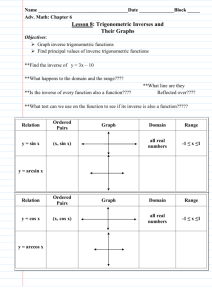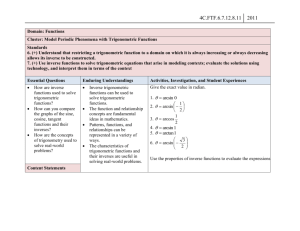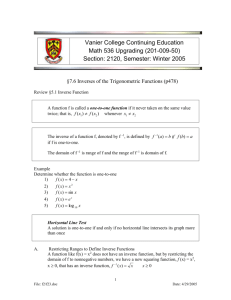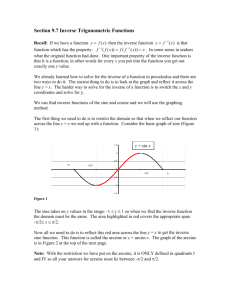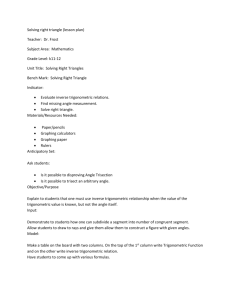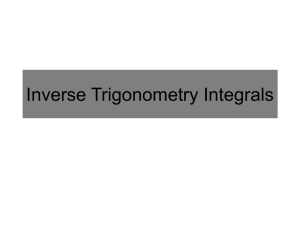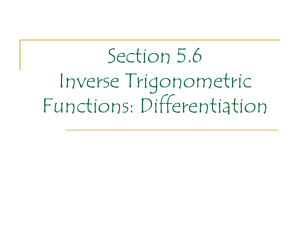Module 5 Lesson 2 Notes
advertisement
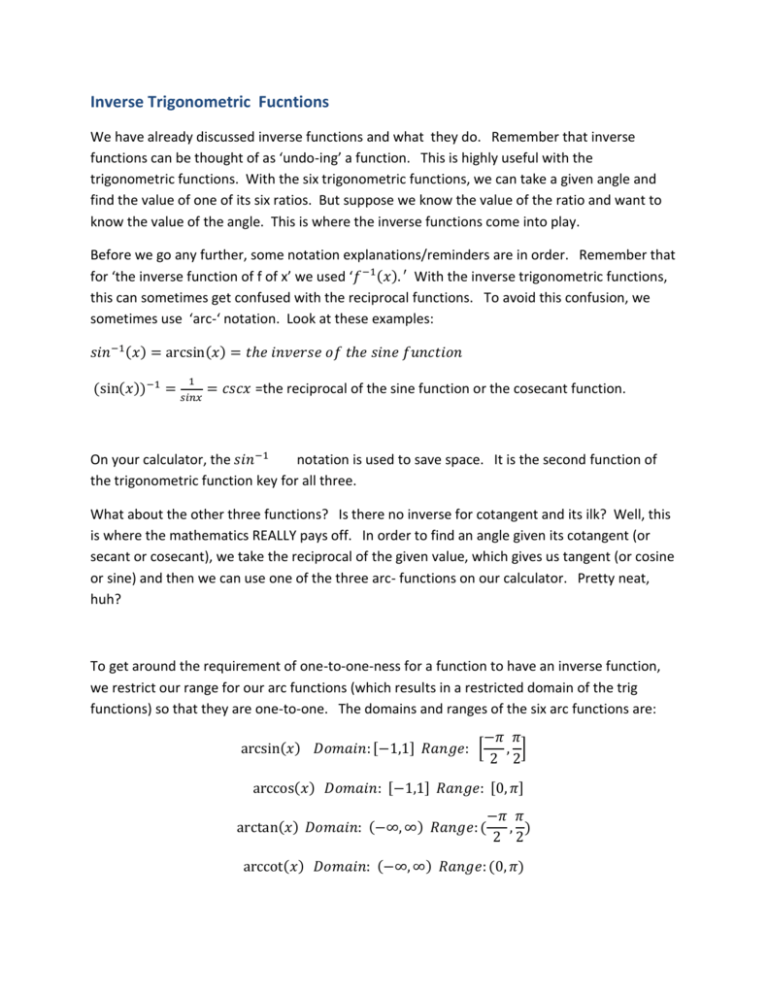
Inverse Trigonometric Fucntions
We have already discussed inverse functions and what they do. Remember that inverse
functions can be thought of as ‘undo-ing’ a function. This is highly useful with the
trigonometric functions. With the six trigonometric functions, we can take a given angle and
find the value of one of its six ratios. But suppose we know the value of the ratio and want to
know the value of the angle. This is where the inverse functions come into play.
Before we go any further, some notation explanations/reminders are in order. Remember that
for ‘the inverse function of f of x’ we used ‘𝑓 −1 (𝑥). ′ With the inverse trigonometric functions,
this can sometimes get confused with the reciprocal functions. To avoid this confusion, we
sometimes use ‘arc-‘ notation. Look at these examples:
𝑠𝑖𝑛−1 (𝑥) = arcsin(𝑥) = 𝑡ℎ𝑒 𝑖𝑛𝑣𝑒𝑟𝑠𝑒 𝑜𝑓 𝑡ℎ𝑒 𝑠𝑖𝑛𝑒 𝑓𝑢𝑛𝑐𝑡𝑖𝑜𝑛
1
(sin(𝑥))−1 = 𝑠𝑖𝑛𝑥 = 𝑐𝑠𝑐𝑥 =the reciprocal of the sine function or the cosecant function.
On your calculator, the 𝑠𝑖𝑛−1
notation is used to save space. It is the second function of
the trigonometric function key for all three.
What about the other three functions? Is there no inverse for cotangent and its ilk? Well, this
is where the mathematics REALLY pays off. In order to find an angle given its cotangent (or
secant or cosecant), we take the reciprocal of the given value, which gives us tangent (or cosine
or sine) and then we can use one of the three arc- functions on our calculator. Pretty neat,
huh?
To get around the requirement of one-to-one-ness for a function to have an inverse function,
we restrict our range for our arc functions (which results in a restricted domain of the trig
functions) so that they are one-to-one. The domains and ranges of the six arc functions are:
arcsin(𝑥) 𝐷𝑜𝑚𝑎𝑖𝑛: [−1,1] 𝑅𝑎𝑛𝑔𝑒: [
−𝜋 𝜋
, ]
2 2
arccos(𝑥) 𝐷𝑜𝑚𝑎𝑖𝑛: [−1,1] 𝑅𝑎𝑛𝑔𝑒: [0, 𝜋]
arctan(𝑥) 𝐷𝑜𝑚𝑎𝑖𝑛: (−∞, ∞) 𝑅𝑎𝑛𝑔𝑒: (
−𝜋 𝜋
, )
2 2
arccot(𝑥) 𝐷𝑜𝑚𝑎𝑖𝑛: (−∞, ∞) 𝑅𝑎𝑛𝑔𝑒: (0, 𝜋)
𝜋
arcsec(𝑥) 𝐷𝑜𝑚𝑎𝑖𝑛: (−∞, −1] ∪ [1, ∞) 𝑅𝑎𝑛𝑔𝑒: [0, 𝜋] − { }
2
−𝜋 𝜋
, ] − {0}
2 2
arccsc(𝑥) 𝐷𝑜𝑚𝑎𝑖𝑛: (−∞, −1] ∪ [1, ∞) 𝑅𝑎𝑛𝑔𝑒: [
𝜋
[NOTE: the notation in the Range is read as “not 2 ” and “not 0” meaning they are excluded]
These restrictions make for some interesting results when we compose the functions with their
inverses. When composed in the order: 𝑓𝑢𝑛𝑐𝑡𝑖𝑜𝑛(𝑎𝑟𝑐𝑓𝑢𝑛𝑡𝑖𝑜𝑛(𝑥)), we get the expected
result of x (assuming x is in the domain of the arcfunction). But when we put them in the
opposite order: 𝑎𝑟𝑐𝑓𝑢𝑛𝑐𝑡𝑖𝑜𝑛(𝑓𝑢𝑛𝑐𝑡𝑖𝑜𝑛(𝑥)), we get a reference angle for x which may or may
not be equal to x.
Try it on your calculator to see (radians!!!!)
1. sin(arcsin(. 3124))
3𝜋
2. tan(arctan(315))
3. arcsin(sin ( 4 ))
4. arccos(cos(4𝜋))
5. arccos(cos(𝜋))
6. sin(arcsin(−3))
Notice that in 1, 2 and 5 you get exactly what you would expect. In 3 and 4 you get a reference
angle. Number 6 should give you an error message. Remember to be aware of the domain!!!
